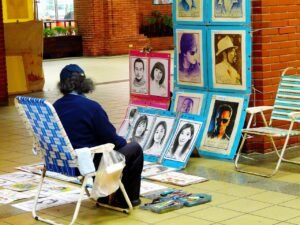Know Your Local Art Ecosystem
Unlocking effective marketing strategies for selling art locally can transform your creative practice from isolated studio work into a thriving, community-based business. While the internet has its perks, local sales offer emotional connection, quicker feedback, and repeat clientele who care about supporting artists in their community. Whether you’re just starting or looking to deepen your roots, local marketing done right builds both visibility and trust.

credit: mauroduque
This guide explores practical, proven methods to sell art in your own town or region—and it’s packed with actionable tips for artists who prefer direct connection over digital clutter.
Before choosing marketing strategies, understand the local landscape:
- What art events, galleries, or community groups exist nearby?
- Where do people in your area buy art: coffee shops, gift stores, pop-up fairs, or co-ops?
- Are there local newsletters, Facebook groups, or business associations for creatives?
Get to know community organizations, economic development programs, and neighborhood venues open to artist collaborations. This insight will help you tailor efforts and avoid wasted energy.
Build a Physical Presence with Pop-Ups and Markets
Local art fairs, craft shows, and pop-up markets are some of the most effective marketing strategies for selling art locally. These venues offer face-to-face interactions, immediate feedback, and the potential to convert passersby into collectors.
To maximize your presence:
- Create a visually inviting booth with clear signage
- Accept mobile payments (like Square or Venmo)
- Offer a range of price points, including prints or small originals
- Collect emails or social handles for future contact
Bonus tip: Bundle mini pieces as “gift-sized” items to attract non-collectors looking for meaningful, affordable art.
Partner with Local Businesses
Think beyond traditional galleries. Many non-art venues love to display original work, including:
- Cafes and restaurants
- Yoga studios and wellness centers
- Salons, barbershops, and spas
- Bookstores, boutiques, and coworking spaces
Approach businesses with a simple lookbook or printed catalog. Offer to refresh pieces seasonally. This strategy exposes your art to foot traffic in an organic, low-pressure setting.
Host an Open Studio or Private Showing
Open studio events offer potential buyers a behind-the-scenes look at your process. People love seeing where the art is made—it builds connection and value.
Tips for success:
- Schedule during an existing art crawl or create your own invite list
- Offer refreshments and ambient music to encourage lingering
- Share the event on local calendars, Facebook groups, and email lists
- Have business cards, pricing sheets, and takeaway items on hand
Alternatively, try hosting a private home showing—especially around the holidays or after releasing a new series.
Cultivate Local SEO for Artist Visibility
Even if you don’t sell directly online, people still Google things like “original art in [your town].” Optimizing your online presence ensures they find you.
Key local SEO tips:
- Create a Google Business Profile with accurate hours, location, and photos
- Add keywords like “local artist,” “affordable art near me,” or “[your town] art studio” to your site or blog
- Use location-based hashtags in social media posts
Being discoverable is one of the most overlooked but effective marketing strategies for selling art locally.
Leverage Word-of-Mouth and Referral Incentives
Word-of-mouth remains one of the most powerful forms of local art marketing. Encourage happy buyers to talk about your work—and make it easy for them to do so.
Strategies include:
- Include thank-you cards with social media handles
- Offer referral perks like discounts on future work
- Display QR codes linking to your portfolio
- Ask for testimonials to post on your website
Personal recommendations build social proof and encourage community engagement.
Get Press in Local Media
Small-town papers, regional blogs, and community radio stations are often hungry for local content—and you’re an ideal feature.
How to land coverage:
- Pitch your story or an upcoming event with a short, professional email
- Include quality images and a brief bio
- Tie your story to a timely hook like an exhibition, fundraiser, or local issue
Mentioning that you’re a local artist supporting the community gives journalists a reason to share your work.
Use Email Lists and Print Collateral
Digital marketing is essential—but direct communication is gold. Build an email list from every event and use it well:
- Send monthly updates about new work, events, or limited-time offers
- Include personal notes or behind-the-scenes photos for engagement
- Keep it short, visual, and easy to skim
Also, don’t overlook physical marketing: postcards, rack cards, stickers, or mini zines placed in local businesses can draw traffic back to your studio.
Engage with Local Art Organizations and Schools
Volunteering, teaching workshops, or jurying local competitions builds visibility and credibility. Consider:
- Hosting a youth art class or sketch club
- Donating a piece to a local silent auction
- Attending city council or arts board meetings
- Collaborating with art teachers or nonprofits
These activities showcase your presence and commitment—and position you as a cultural contributor, not just a seller.

Sketchbooks.org | TIPS AND HACKS
Sketchbook as a Sanctuary | Sketching Calm and Creativity in Your Pages
Why Your Sketchbook Can Be a Safe Space A sketchbook is more than a creative outlet—it’s a sanctuary for mindfulness, reflection, and imagination. In a world that often feels loud and fast, sketching provides a...
Frequently Asked Questions
Do I need a physical storefront to sell art locally?
No—a home studio, shared space, or popup presence can be just as effective.
What’s the best local venue to start selling my art?
Start with accessible spots like community markets, coffee shops, or library galleries.
How do I price my work for a local audience?
Offer a range of prices and sizes to meet varied budgets, and be transparent about materials and time investment.
Should I have a website even if I don’t sell online?
Yes—your website acts as your digital storefront and helps people find you through local web searches.
How do I get people to attend my art events?
Promote through email lists, local social groups, business partners, and word-of-mouth—people love a personal invitation.
Can social media help with local sales?
Absolutely—using geo-tags, local hashtags, and neighborhood groups amplifies your visibility.
What if there are already lots of artists in my town?
Lean into your unique style and voice—your story and subject matter set you apart.
Final Thoughts
Mastering effective marketing strategies for selling art locally that actually work doesn’t require a huge budget—it requires presence, intention, and community connection. When you show up authentically and strategically—both in person and online—you create opportunities for genuine engagement and loyal patronage.
Local buyers aren’t just purchasing art. They’re investing in your vision, your story, and the shared experience of place. Lead with purpose, follow with consistency, and your collector base will grow—one conversation, one handshake, and one piece at a time.

credit: worksofkwai
Ready to Share Your Work?











I loved the idea that selling local means being seen—not just being sold.
free wine!